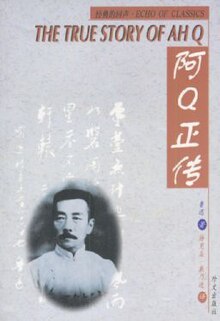
Back Die wahre Geschichte des Ah Q German La Vera Historio de Ah Q Esperanto La verdadera historia de Ah Q Spanish La Véritable Histoire de Ah Q French Kisah nyata Ah Q ID 阿Q正伝 Japanese 아Q정전 Korean А-Кьюгийн үнэн түүх Mongolian Den sanne historien om Ah Q NB ਆ ਕਿਊ ਦੀ ਸੱਚੀ ਕਹਾਣੀ Punjabi
 One of the reprints after 1923 with the author and English title on the cover | |
| Author | Lu Xun |
|---|---|
| Original title | 阿Q正傳 |
| Language | Vernacular Chinese |
Publication date | 1921 |
| Publication place | China |
| The True Story of Ah Q | |||||||||||||||||
|---|---|---|---|---|---|---|---|---|---|---|---|---|---|---|---|---|---|
| Traditional Chinese | 阿Q正傳 | ||||||||||||||||
| Simplified Chinese | 阿Q正传 | ||||||||||||||||
| |||||||||||||||||
The True Story of Ah Q is an episodic novella written by Lu Xun using third-person narration perspective, first published as a serial between December 4, 1921 and February 12, 1922. It was later placed in his first short story collection Call to Arms (吶喊; Nàhǎn) in 1923 and is the longest story in the collection. The piece is generally held to be a masterpiece of modern Chinese literature, since it is considered the first piece of work to fully utilize vernacular Chinese after the 1919 May 4th Movement in China.[1]
It was first published in the Beijing Morning News supplement as a serial. Originally Lu Xun wrote the story under the name "Ba Ren" (巴人, "crude fellow"), and so few people knew who wrote the novella.[2] The first installment was published on December 4, 1921, and additional installments appeared weekly or fortnightly. The final installment was published on February 12, 1922. The story had nine chapters.[3]
Furthermore, The True Story of Ah Q also achieved considerable international influence. As reported by Chinawriter, the translation of the novella began in 1925, indicating its early recognition abroad. During Lu Xun's lifetime, the work was translated into eight languages: Russian, English, French, Japanese, German, Czech, Korean, and Esperanto. Remarkably, Lu Xun personally encountered several of these translations, actively participating in the proofreading process for some.[4] Expanding upon Lu Xun's international reach, Peng Xiaoling and Han Aili's article, "Ah Q: 70 years", found in Paul B. Foster's journal article, documents the novella's translation into over thirty languages, its adaptation into more than sixty reprints, dramatic renditions, a film, a ballet, and even its artistic expressions through cartoons and woodcuts.[5]
- ^ Luo, Jing. [2004] (2004). "Over a Cup of Tea: An Introduction to Chinese Life and Culture". University Press of America. ISBN 0-7618-2937-7[page needed]
- ^ Davies, p. 58. "When Lu Xun's prose fiction, The True Story of Ah Q was first published as a serial in the Beijing Morning News supplement in 1921, it was a tremendous success and readers throughout China were intrigued by the question of whether the portrayal of Ah Q was based on a real person. The disturbing realism of Lu Xun's story, according to Gao Yihan, led many people to suspect that the incidents related in the tale referred to them:"
- ^ Tambling, Jeremy. "Lu Xun: The True Story." Madmen and Other Survivors. Hong Kong University Press, HKU, 2007., p. 57.
- ^ 侯桂新 (22 September 2022). "何谓阿Q的"行状"?——兼谈如何读懂鲁迅--文史--中国作家网" [What is Ah Q's 'career'? ——Also talk about how to understand Lu Xun]. 鲁迅研究月刊 [Lu Xun Research Monthly]. chinawriter.com.cn.
- ^ Foster, Paul B. (2001). "The Ironic Inflation of Chinese National Character: Lu Xun's International Reputation, Romain Rolland's Critique of 'The True Story of Ah Q,' and the Nobel Prize". Modern Chinese Literature and Culture. 13 (1): 140–168. JSTOR 41490846.